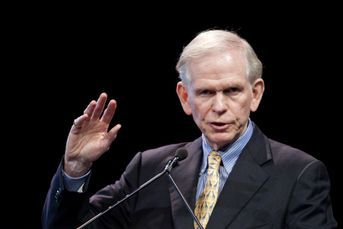Fidelity, DoubleLine take different emerging-markets bond approach but have something in common
Managers use U.S. dollar-denominated bonds, avoid 2013's slide in developing-country currencies.
Fidelity Investments’ John Carlson and DoubleLine Capital’s Luz Padilla pursue different strategies in their emerging-market debt funds. One thing they have in common is buying bonds denominated in U.S. dollars.
That decision enabled them to sidestep 2013’s slide in developing-country currencies and turn in the best risk-adjusted performance among U.S. emerging-markets bond funds over the past three years, according to the Bloomberg riskless-return ranking. Funds that owned local-currency bonds, including the biggest in the peer group, the $10.7 billion Pimco Emerging Local Bond Fund, wound up near the bottom of the list.
The Federal Reserve’s signal in May that it would scale back its bond-buying program sent emerging-markets currencies tumbling on fears that investors would shift money away from developing nations. The decline was exacerbated later in the year by concern that China’s economy was slowing and by political turmoil in countries from Argentina to Turkey to Ukraine.
(See also: Emerging-markets fixed income: A constructive view for the discriminating eye)
“A few years ago, I was constantly getting pressure from investors to put money into currencies,” said Ms. Padilla, manager of the $500 million DoubleLine Emerging Markets Fixed Income Fund. “We just didn’t think the potential return was commensurate with the risk.”
Bloomberg’s index tracking dollar-denominated debt from emerging countries returned an annualized 6.6% in the three-year period ended Feb. 24, compared with 2.7% for a barometer of local-currency bonds.
SEEING ‘DOWNSIDE’
Companies including TCW Group Inc. and MFS Investment Management created funds dedicated to local-currency bonds in recent years to take advantage of growing interest in the category. Investors poured $5.2 billion into the Pimco Emerging Local Bond Fund in the three-year period ended Jan. 31, the most collected by any fund in the group, according to estimates from Morningstar Inc.
(For stock lovers: It’s a stock pickers’ game in emerging markets)
“People were looking for diversification and greater returns,” said Karin Anderson, a Morningstar analyst. “More recently, they’ve seen the downside currencies can inflict.”
Bloomberg’s risk-adjusted return is calculated by dividing total return by volatility, or the degree of daily price-swing variation, giving a measure of income per unit risk. The returns aren’t annualized.
Mr. Carlson’s $4.3 billion Fidelity New Markets Income Fund had a risk-adjusted gain of 4.5% in the three-year period ended Feb. 24. The fund, with less than 5% of holdings in local-currency bonds as of Dec. 31, had the second-highest absolute return and lower-than-average volatility in a group of 27 emerging-markets bond funds with at least $250 million in assets.
The DoubleLine emerging-markets fund, with no local currency bonds, gained a risk-adjusted 4.3% by combining above-average returns and the lowest volatility.
Ms. Padilla joined TCW in 1994 and became co-manager of its emerging-market bond fund in 2001. She was lead manager of the fund from October 2006 to December 2009 as it outperformed 99% of peers, according to Morningstar. She moved to DoubleLine in December 2009 when Jeffrey Gundlach founded the firm after being fired from TCW in a dispute.
Ms. Padilla, unlike Mr. Carlson, has long favored corporate bonds over government securities, saying they are a better way to benefit from the improving economic fundamentals of developing countries. Her fund had 83% of its assets in corporate debt as of Jan. 31, and 14% in quasi-sovereigns, or bonds from state-run companies such as Russia’s Gazprom OAO.
ARGENTINE PESO
The manager said she began hearing in 2010 from central bankers in the developing world who believed their currencies had become overvalued after rallying from market lows in March 2009. Concluding that potential appreciation of the currencies was limited, she decided to stick to dollar-denominated debt. Over the past three years, the Argentine peso dropped 49%, the Brazilian real 29% and the Turkish lira 27% against the U.S. dollar.
Her fund is heavily concentrated in Latin America, with no exposure to the troubled economies of Argentina and Venezuela, whose dollar-denominated bonds fell 11% and 9.9% this year through Feb. 24, according to data compiled by Bloomberg. In Venezuela, the government of President Nicolas Maduro has been battling street protests since early this month. In Argentina, consumer prices surged 3.7% in January, the most in more than a decade.
“Why would I want to put our investors’ money at risk?” Ms. Padilla said of her decision to avoid both countries. “I would rather not do that, even if sometimes I may be leaving money on the table.”
Mr. Carlson, by contrast, has often made Venezuelan debt the largest holding in his fund. Venezuelan bonds represented 15% of the Fidelity New Markets Income Fund at the end of 2011 and 13% at the end of 2012, according to regulatory filings. The bonds returned 15% in 2011 and 38% the next year, according to data compiled by Bloomberg.
Asked about Venezuela in an April 2013 interview with Forbes magazine, Mr. Carlson said: “There are two questions. Do they have the ability to pay? Do they have a willingness to pay?”
Mr. Carlson cut Venezuelan debt to 7.8% as of Dec. 31, data from the Fidelity website show. He reduced Turkish debt to 3.3%, from 8.4% at end of 2012. Turkey’s dollar-denominated debt fell 13% last year, according to data compiled by Bloomberg.
Mr. Carlson was traveling and unavailable to comment, said Charles Keller, a spokesman for Fidelity Investments.
Mr. Carlson, who has run the fund since 1995, has beaten at least 84% of peers over the past five- and 10-year periods, according to Morningstar, which named him fixed-income manager of the year for 2011.
He concentrates his holdings in sovereign debt, seeking to identify countries “that are not well understood and that we believe offer significant upside potential,” Fidelity wrote in its fourth-quarter performance review.
The manager can have as much as 20% of the fund in local currency debt, a self-imposed limit rather than a prospectus rule.
Paul Denoon, who oversees $29 billion of emerging-markets debt at AllianceBernstein, said the selloff in local currency bonds has gotten too extreme.
“It has gone way beyond the fundamentals,” said Mr. Denoon, who is using the opportunity to add exposure to the bonds across a number of portfolios.
Mutual funds tend to concentrate in dollar- or local-denominated debt, although managers often have the option of moving between the two when they see opportunities. At the $4.9 billion TCW Emerging Markets Income Fund, local currency bonds have ranged from zero to one-third of the holdings, said David Robbins, one of the managers.
Given the drop in emerging-markets currencies, the local debt will become the more compelling asset class at some point, he said. Robbins’s fund had 95% of its assets in dollars as of Jan. 31, according to the TCW website.
Ms. Padilla said the risk still outweighs the reward.
(Bloomberg News)
Learn more about reprints and licensing for this article.








